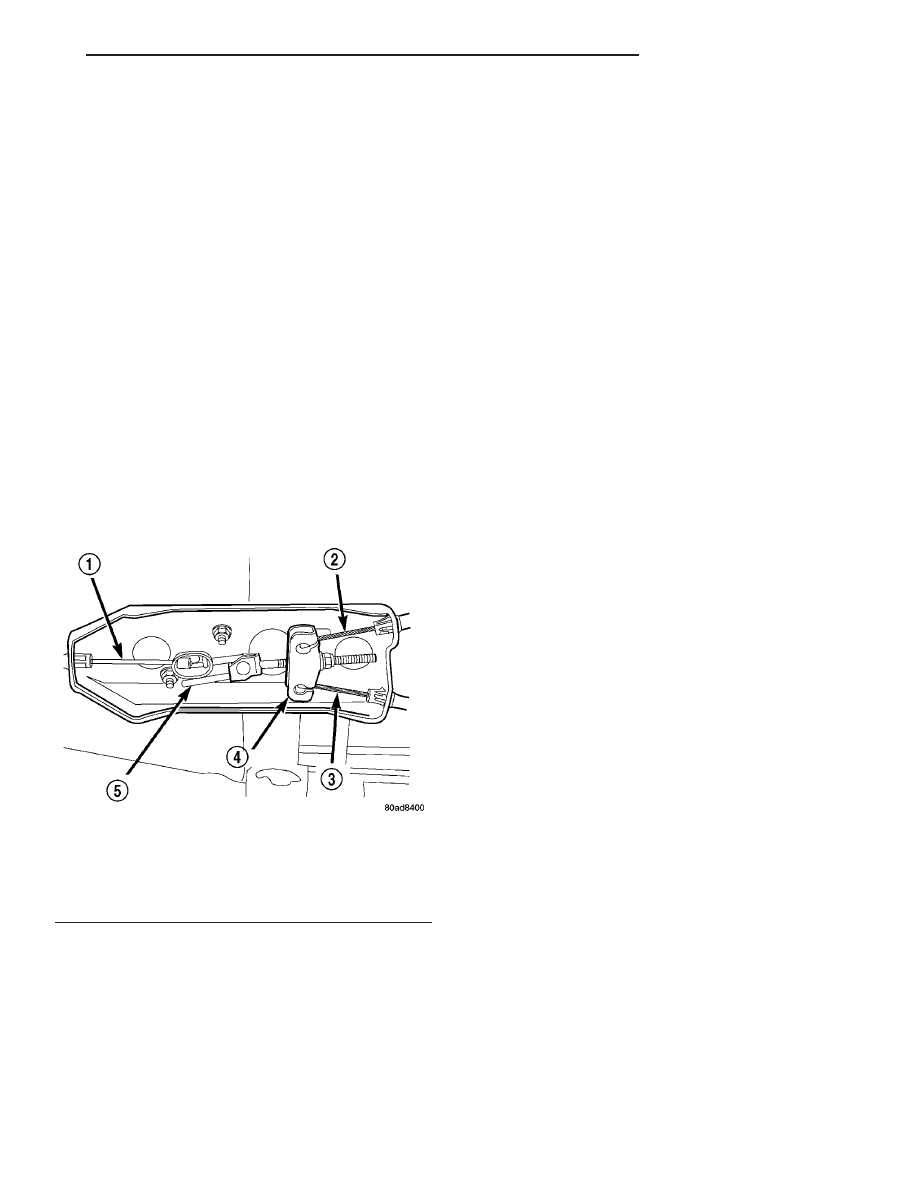Jeep Wrangler TJ. Manual - part 254

(6) Install the rotor (Refer to 5 - BRAKES/HY-
DRAULIC/MECHANICAL/ROTORS
-
INSTALLA-
TION).
(7) Install the caliper (Refer to 5 - BRAKES/HY-
DRAULIC/MECHANICAL/DISC BRAKE CALIPERS
- INSTALLATION).
(8) Install the wheel and tire assembly (Refer to 22
- TIRES/WHEELS/WHEELS - STANDARD PROCE-
DURE).
PARKING BRAKE
DESCRIPTION
The parking bake is a hand lever and cable oper-
ated system used to apply the rear brakes.
OPERATION
A hand operated lever in the passenger compart-
ment is the main application device. The front cable
is connected between the hand lever and the ten-
sioner. The tensioner rod is attached to the equalizer
which is the connecting point for the rear cables (Fig.
60).
The rear cables are connected to the actuating
lever on each secondary brake shoe. The levers are
attached to the brake shoes by a pin either pressed
into, or welded to the lever. A clip is used to secure
the pin in the brake shoe. The pin allows each lever
to pivot independently of the brake shoe.
To apply the parking brakes, the hand lever is
pulled upward. This pulls the rear brake shoe actu-
ating levers forward, by means tensioner and cables.
As the actuating lever is pulled forward, the parking
brake strut (which is connected to both shoes), exerts
a linear force against the primary brake shoe. This
action presses the primary shoe into contact with the
drum. Once the primary shoe contacts the drum,
force is exerted through the strut. This force is trans-
ferred through the strut to the secondary brake shoe
causing it to pivot into the drum as well.
A gear type ratcheting mechanism is used to hold
the lever in an applied position. Parking brake
release is accomplished by the hand lever release
button.
A parking brake switch is mounted on the parking
brake lever and is actuated by movement of the
lever. The switch, which is in circuit with the red
warning light in the dash, will illuminate the warn-
ing light whenever the parking brakes are applied.
Parking brake adjustment is controlled by a cable
tensioner mechanism. The cable tensioner, once
adjusted at the factory, should not need further
adjustment under normal circumstances. Adjustment
may be required if a new tensioner, or cables are
installed, or disconnected.
DIAGNOSIS AND TESTING - PARKING BRAKE
NOTE: Parking brake adjustment is controlled by a
cable tensioner. Once the tensioner is adjusted at
the factory, it should not require further attention.
However, there are two instances when adjustment
will be required. The first is when a new tensioner,
or cables have been installed. And the second, is
when the tensioner and cables are disconnected for
access to other brake components.
The parking brake switch is in circuit with the red
warning lamp in the dash. The switch will cause the
lamp to illuminate only when the parking brakes are
applied. If the lamp remains on after parking brake
release, the switch or wires are faulty, or cable ten-
sioner adjustment is incorrect.
In most cases, the actual cause of an improperly
functioning parking brake (too loose/too tight/won’t
hold), can be traced to a parking brake component.
The leading cause of improper parking brake oper-
ation, is excessive clearance between the parking
brake shoes and the shoe braking surface. Excessive
clearance is a result of lining and/or drum wear,
drum surface machined oversize, or inoperative
adjuster components.
Excessive parking brake lever travel (sometimes
described as a loose lever or too loose condition), is
the result of worn brake shoes, improper brake shoe
adjustment, or improperly assembled brake parts.
A condition where the parking brakes do not hold,
will most probably be due to a wheel brake compo-
nent.
Fig. 60 Parking Brake Components
1 - FRONT CABLE
2 - L.R. CABLE
3 - R.R. CABLE
4 - EQUALIZER
5 - TENSIONER ROD
TJ
BRAKES - BASE
5 - 33
SUPPORT PLATE (Continued)